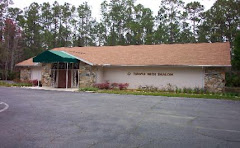




 The students of the Temple Beth Shalom Religious School now have significant experience with the Lulav and the Etrog, fulfilling the commandment to take four species during the Festival of Sukkot, the Feast of Tabernacles, described in the Book of Leviticus. After discussing the week-long Sukkot festival, specific instructions for how to celebrate the holiday are given. Leviticus 23:40 instructs: “On the first day you shall take the product of hadar trees, branches of palm trees, boughs of leafy trees, and willows of the brook, and you shall rejoice before Adonai your God seven days." These are the four species that form the lulav and etrog. The four species are waved in the synagogue as part of the service during the holiday of Sukkot. Traditionally, they are not waved on Shabbat because bringing these items to the synagogue would violate the prohibition against carrying. Some liberal synagogues do wave the lulav and etrog on Shabbat. While it is customary for each individual to have a lulav and etrog, many synagogues leave some sets in the synagogue sukkah for the use of their members. The lulav and etrog may also be waved at home.
The students of the Temple Beth Shalom Religious School now have significant experience with the Lulav and the Etrog, fulfilling the commandment to take four species during the Festival of Sukkot, the Feast of Tabernacles, described in the Book of Leviticus. After discussing the week-long Sukkot festival, specific instructions for how to celebrate the holiday are given. Leviticus 23:40 instructs: “On the first day you shall take the product of hadar trees, branches of palm trees, boughs of leafy trees, and willows of the brook, and you shall rejoice before Adonai your God seven days." These are the four species that form the lulav and etrog. The four species are waved in the synagogue as part of the service during the holiday of Sukkot. Traditionally, they are not waved on Shabbat because bringing these items to the synagogue would violate the prohibition against carrying. Some liberal synagogues do wave the lulav and etrog on Shabbat. While it is customary for each individual to have a lulav and etrog, many synagogues leave some sets in the synagogue sukkah for the use of their members. The lulav and etrog may also be waved at home.It is a positive commandment from the Torah [Leviticus 23:40] to gather together the Four Species during Sukkot:
"The first day" refers to the first day of Sukkot. "Fruit of goodly trees" refers to the etrog (citron). "Branches of palm trees" refers to the lulav. "Boughs of leafy trees" refers to the myrtle. "Willows of the brook" refers to the aravot or hoshanot.
The four are lumped together under the inclusive term lulav, since the lulav is the largest and most prominent. Thus, while the mitzvah is to wave the lulav, this actually refers to the four taken together as one.
How the Four Fit Together
The lulav is a single palm branch and occupies the central position in the grouping. It comes with a holder-like contraption (made from its own leaves) which has two extensions. With the backbone (the solid spine) of the lulav facing you and this holder in place near the bottom, two willow branches are placed in the left extension and three myrtle branches are placed in the right. The myrtle should extend to a greater height than the willows.
This whole cluster is held in the right hand, the etrog is held in the left, and the two should be touching one another. Some have the custom of picking up the etrog first and then the lulav--reversing the order when putting them down--because the etrog is referred to before the others in the biblical verse.

No comments:
Post a Comment